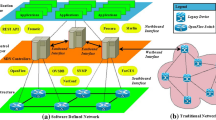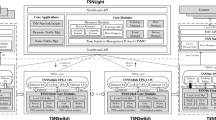Abstract
The throughput degradation of Transport Control Protocol (TCP)/Internet Protocol (IP) networks over lossy links due to the coexistence of congestion losses and link corruption losses is very similar to the degradation of processor performance (i.e., cycle per instruction) due to control hazards in computer design. First, two types of loss events in networks with lossy links are analogous to two possibilities of a branching result in computers (taken vs. not taken). Secondly, both problems result in performance degradations in their applications, i.e., penalties (in clock cycles) in a processor, and throughput degradation (in bits per second) in a TCP/IP network. This has motivated us to apply speculative techniques (i.e., speculating on the outcome of branch predictions), used to overcome control dependencies in a processor, for throughput improvements when lossy links are involved in TCP/IP connections. The objective of this paper is to propose a cross-layer network architecture to improve the network throughput over lossy links. The system consists of protocol-level speculation based algorithms at transport layer, and protocol enhancements at middleware and network layers that provide control and performance parameters to transport layer functions. Simulation results show that, compared with prior research, our proposed system is effective in improving network throughput over lossy links, capable of handling incorrect speculations, fair for other competing flows, backward compatible with legacy networks, and relatively easy to implement.










Similar content being viewed by others
References
Bai, H., Fu, S., & Atiquzzaman, M. (2005). Transport layer design in mobile wireless networks. In Y. Pan & Y. Xiao (Eds.), Invited book chapter in design and analysis of wireless networks. Hauppauge, NY: Nova Science.
Wang, S. Y., & Kung, H. T. (2001). Use of TCP decoupling in improving TCP performance over wireless networks. ACM Wireless Networks, 7(3), 221–236.
Akyildiz, I. F., Morabito, G., & Palazzo, S. (2001). TCP-peach: A new congestion control scheme for satellite IP networks. IEEE/ACM Transactions on Networking, 9(3), 307–321.
Sinha, P., Venkitaraman, N., Sivakumar, R., & Bharghavan, V. (1999). WTCP: A reliable transport protocol for wireless wide-area networks. In Proceedings of ACM/IEEE MOBICOM (pp. 231–241), Seattle, WA.
Goel, S., & Sanghi, D. (1998). Improving performance of TCP over wireless links. In Proceedings of IEEE TENCON (pp. 332–335).
Balakrishnan, H., & Katz, R. (1998). Explicit loss notification and wireless web performance. In Proceedings of IEEE Globecom Internet Mini Conference. Sydney, Australia.
Bai, H., & Lilja, D. (2005). Buffer requirements at ECN-capable RED gateways to minimize packet losses. In IEEE electro information technology conference. Lincoln, NE.
Bai, H., Lilja, D., & Atiquzzaman, M. (2005). Applying speculative technique to improve TCP throughput over lossy links. In IEEE GLOBECOM. St. Louis, MO.
Hennessy, J. L., & Patterson, D. A. (2003). Computer architecture: A quantitative approach (3rd ed.). Los Altos: Morgan Kaufmann.
Chen, Y., Sendag, R., & Lilja, D. (2003). Using incorrect speculation to prefetch data in a concurrent multithreaded processor. In 17th International parallel and distributed processing symposium. Nice, France.
Bai, H., & Atiquzzaman, M. (2003). Error modeling schemes for fading channels in wireless communications: A survey. IEEE Communications Surveys and Tutorials, 5(2), 2–9.
Dawkins, S., Montenegro, G., Kojo, M., Magret, V., & Vaidya, N. (2001). End-to-end performance implications of links with errors. RFC 3155.
Cen, S., Cosman, P. C., & Voelker, G. M. (2003). End-to-end differentiation of congestion and wireless losses. IEEE/ACM Transactions on Networking, 11(5), 703–717.
Floyd, S. (1994). TCP and explicit congestion notification. ACM Computer Communication Review, 24(5), 10–23.
Floyd, S., & Jacobson, V. (1993). Random early detection gateways for congestion avoidance. IEEE/ACM Transaction on Networking, 1, 397–413.
Zheng, B., & Atiquzzaman, M. (2004). Active queue management in TCP/IP networks. In M. Hassan & R. Jain (Eds.), High performance TCP/IP networking: Concepts, issues, and solutions (pp. 281–307). Prentice: Prentice-Hall.
Liu, C., & Jain, R. (2001). Improving explicit congestion notification with the mark-front strategy. Computer Networks, 35(2–3), 185–201.
Kunniyur, S., & Srikant, R. (2003). End-to-end congestion control schemes: Utility functions, random losses and ECN marks. IEEE/ACM Transactions on Networking, 11(5), 689–702.
Biaz, S., & Vaidya, N. H. (1999). Discriminating congestion losses from wireless losses using inter-arrival times at the receiver. In IEEE ASSET symposium. Richardson, TX, USA.
Biaz, S., & Vaidya, N. (1998). Discriminating congestion losses from wireless losses: A negative result. In Seventh international conference on computer communications and networks. New Orleans, LA, USA.
Ramakrishnan, K., & Floyd, S. (1999). A proposal to add explicit congestion notification (ECN) to IP. RFC 2481.
Bonald, T., May, M., & Bolot, J. (2000). Analytic evaluation of RED performance. In INFOCOM (pp. 1415–1424). Tel-Aviv, Israel.
Misra, V., Gong, W., & Towsley, D. (2000). Fluid-based analysis of a network of AQM routers supporting TCP flows with an applicaiton to RED. In ACM SIGCOMM (pp. 151–160), Stockholm, Sweden.
Abouzeid, A., & Roy, S. (2000). Analytic understanding of RED gateways with mutiple competing TCP flows. In IEEE GLOBECOM (pp. 555–560), San Francisco, CA.
Abouzeid, A., Roy, S., & Azizoglu, M. (2000). Stochastic modeling of TCP over lossy links. In INFOCOM Tel Aviv, Israel.
Mistra, A., Ott, T., & Baras, J. (1999). The window distribution of multiple TCPs with random loss queues. In IEEE GLOBECOM (pp. 1714–1726). Rio de Janeiro, Brazil.
Balakrishnan, H., Seshan, S., & Katz, R. (1995). Improving reliable transport and handoff performance in cellular wireless networks. ACM Wireless Networks, 1(4), 469–481.
Casetti, C., Gerla, M., Lee, S., Sanadidi, M., & Wang, R. (2001). TCP westwood: Bandwidth estimation for enhanced transport over wireless links. In Proceedings of ACM Mobicom (pp. 287–297). Rome, Italy.
Jain, R. (1991). The art of computer systems performance analysis: Techniques for experimental design, measurement, simulation and modeling. New York: John Wiley.
Author information
Authors and Affiliations
Corresponding author
Rights and permissions
About this article
Cite this article
Bai, H., Lilja, D.J. & Atiquzzaman, M. Cross-layer speculative architecture for end systems and gateways in computer networks with lossy links. Wireless Netw 16, 1621–1638 (2010). https://doi.org/10.1007/s11276-009-0218-6
Published:
Issue Date:
DOI: https://doi.org/10.1007/s11276-009-0218-6




